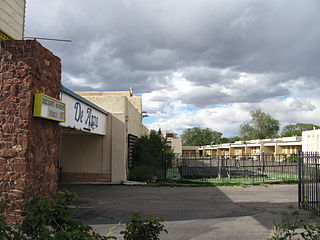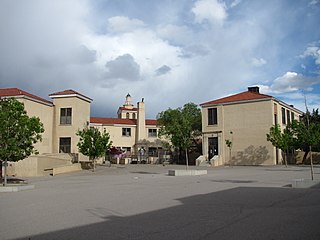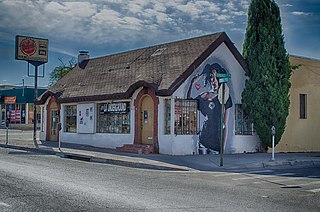
San Felipe de Neri Church is a historic Catholic church located on the north side of Old Town Plaza in Albuquerque, New Mexico. Built in 1793, it is one of the oldest surviving buildings in the city and the only building in Old Town proven to date to the Spanish colonial period. The church is listed on the New Mexico State Register of Cultural Properties and the National Register of Historic Places and has remained in continuous use for over 200 years.

U.S. Route 66 in the state of Texas extended across the Texas Panhandle from its designation in 1926 to its decommissioning in 1985.

The historic U.S. Route 66 ran east–west across the central part of the state of New Mexico, along the path now taken by Interstate 40 (I-40). However, until 1937, it took a longer route via Los Lunas, Albuquerque, and Santa Fe, now roughly New Mexico State Road 6 (NM 6), I-25, and US 84. Large portions of the old road parallel to I-40 have been designated NM 117, NM 118, NM 122, NM 124, NM 333, three separate loops of I-40 Business, and state-maintained frontage roads.

The Aztec Motel, also known as the Aztec Auto Court or Aztec Lodge, was a historic motel located on former U.S. Route 66 in the Upper Nob Hill neighborhood of Albuquerque, New Mexico, United States. Until its demolition in 2011 it was the oldest continuously-operating Route 66 motel in New Mexico and "one of the five most important motels left" in Albuquerque.

The De Anza Motor Lodge was a historic motel located on former U.S. Route 66 in the Upper Nob Hill neighborhood of Albuquerque, New Mexico. It was built in 1939 by Charles G. Wallace, a local trader of Zuni art and pottery, who remained the owner until 1983. Wallace decorated the motel with a variety of Native American art, including a series of murals by Zuni artist Tony Edaakie in a basement room.

Nob Hill Business Center is a historic shopping center in Albuquerque, New Mexico. Built in 1946–7, it was the first modern suburban shopping center in New Mexico, and its construction marked a shift away from pedestrian-oriented development in Albuquerque in favor of decentralized, auto-oriented sprawl. Located on Central Avenue at Carlisle Boulevard, the building is the focal point of the Nob Hill district.

The Cactus Motor Lodge, now known as the Cactus RV Park, is a motel located along historic U.S. Route 66 in Tucumcari, New Mexico. I.E. and Edna Perry built the lodge in 1941. The motel included three wings of units forming a "U" shape and an office, the latter of which was a dance hall when the motel opened. In 1952, Norm Wegner purchased the motel; Wegner added an artificial stone exterior to the buildings and converted the dance hall to an office. After Route 66 was decommissioned, the motel lost much of its business, and by the 1990s it became an RV park; the motel units are currently unused. The motel's neon sign was restored in 2008. In October 2018, the sign was sold and removed to be relocated to an Albuquerque neon-sign park. Many other items have been sold off as the current owners negotiate to sell the property itself to O'Reilly Auto Parts.

The Employees' New Dormitory and Club, also known as Building 232, is a historic building in Albuquerque, New Mexico. Built in 1931, it is notable as the only surviving building of the Albuquerque Indian School, which operated at this location from 1882 to 1976. It was added to the New Mexico State Register of Cultural Properties in 1981 and the National Register of Historic Places in 1982.

Monte Vista Elementary School is a public elementary school in the Nob Hill neighborhood of Albuquerque, New Mexico, whose campus is listed in the New Mexico State Register of Cultural Properties and the National Register of Historic Places. It is notable as one of the city's best examples of Mediterranean Revival architecture and as the historical focal point of the surrounding neighborhood.

The Charles W. Lewis Building is a historic building in the Barelas neighborhood of Albuquerque, New Mexico. It is listed on the New Mexico State Register of Cultural Properties and the National Register of Historic Places. It was built around 1882 by Charles W. Lewis (1844–1901), a native of Peralta, New Mexico who came to Albuquerque in 1873. Lewis was one of many Albuquerque residents to get involved in land speculation as the Atchison, Topeka and Santa Fe Railway approached the town in the late 1870s. Once the railroad arrived, Lewis was able to subdivide a valuable piece of land near the tracks and used one of the lots for the building described here, which was probably built as rental housing. In 1915 it was reportedly being operated as a saloon.

The El Vado Auto Court is a historic motel in Albuquerque, New Mexico, located along former U.S. Route 66. Built in 1937, it operated until 2005 and reopened in 2018 after renovations. The motel was listed on the New Mexico State Register of Cultural Properties and National Register of Historic Places in 1993, and was also designated an Albuquerque city landmark in 2008.

Nob Hill Motel, formerly the Modern Auto Court, at 3712 Central Ave. SE. in Albuquerque, New Mexico, was built in 1937. It was listed on the National Register of Historic Places in 1993. The listing included four contributing buildings.

The Cottage Bakery is a historic building on Central Avenue in Albuquerque, New Mexico. It was built in 1937 by a local bakery, the Cottage Pure Food Shoppe, and is significant as a relatively unaltered 1930s food-vending establishment, as well as for its use of roadside novelty architecture to attract customers. The front of the building was constructed in the form of a thatched cottage, which was intended to evoke "a bucolic purity that clients would associate with dairy and bakery products". It was listed on the New Mexico State Register of Cultural Properties and the National Register of Historic Places in 1993.

San Jose de los Duranes Chapel is a historic building in Albuquerque, New Mexico. The chapel was built around 1890 to serve the community of Los Duranes, one of several outlying plazas spread along the Rio Grande in the vicinity of the main plaza at Old Town Albuquerque. The chapel was replaced with a new, larger San Jose Church in the 1960s, and fell into disrepair. In 1982–4, community members undertook a restoration of the building, replacing damaged or missing pews, rails, and doors, plastering the walls, repairing holes, and reinstalling the original religious artwork including paintings of the Crucifixion and a santo depicting St. Joseph. It was listed on the New Mexico State Register of Cultural Properties in 1983 and the National Register of Historic Places in 1984.

The Lembke House is a historic house in Albuquerque, New Mexico, and one of the best examples of residential International Style architecture in the city. It was built in 1937 by Charles H. Lembke (1889–1989), a local construction company owner who was also Chairman of the City Commission during the time he occupied the house. It was one of the earlier houses in the Huning Castle neighborhood, an area of large homes that was mostly developed between the 1930s and 1950s. The house was probably constructed as a speculative venture as Lembke lived there for less than a year before selling it. The house was added to the New Mexico State Register of Cultural Properties in 1976 and the National Register of Historic Places in 1980.

The John Pearce House is a historic house in Albuquerque, New Mexico. It is notable for its architecture and as the only extant house on the Downtown section of Central Avenue, which is otherwise occupied entirely by commercial buildings. The house was built in 1905 by Dr. John F. Pearce, one of the city's first physicians. The contractor, Wallace Hesselden, also built the Henry Mann House the same year. After Pearce moved out of the house in 1933, it was used for various functions including a boarding house and chiropractic clinic. In 1982, the house was renovated and converted to office space. The architect for the renovation was Antoine Predock. The property was added to the New Mexico State Register of Cultural Properties and the National Register of Historic Places in 1980. It is next door to another historic structure, the Skinner Building.

The Tower Court is a historic motel on Central Avenue in Albuquerque, New Mexico. It is notable as one of only a few 1930s motels remaining in the city. The motel was built in 1939 by Ben F. Shear and was added to the New Mexico State Register of Cultural Properties and the National Register of Historic Places in 1993.

The Tewa Lodge is a historic motel on Central Avenue in Albuquerque, New Mexico. It is notable as one of the best-preserved Route 66 era motels remaining in the city, and one of the few still operating as a motel. It was built in 1946 and was added to the New Mexico State Register of Cultural Properties and the National Register of Historic Places in 1998.

The Luna Lodge is a historic motel on Central Avenue in Albuquerque, New Mexico, which is notable as one of the best-preserved Route 66 era motels remaining in the city. It was built in 1949 and was one of the easternmost Albuquerque motels, located about 6 miles (9.7 km) from the city center. The motel eventually closed and fell into disrepair, but was restored and converted to low-income housing in 2013. The property was added to the New Mexico State Register of Cultural Properties and the National Register of Historic Places in 1998.

The La Puerta Lodge is a historic motel on Central Avenue in Albuquerque, New Mexico, which is notable as one of the best-preserved Route 66 era motels remaining in the city. It was built in 1949 by Ralph Smith and was one of the easternmost Albuquerque motels, located over 6 miles (9.7 km) from the city center. The property was added to the New Mexico State Register of Cultural Properties in 1997 and the National Register of Historic Places in 1998.





















